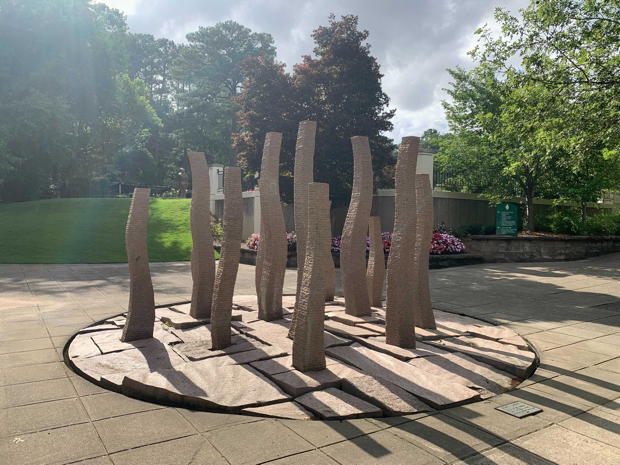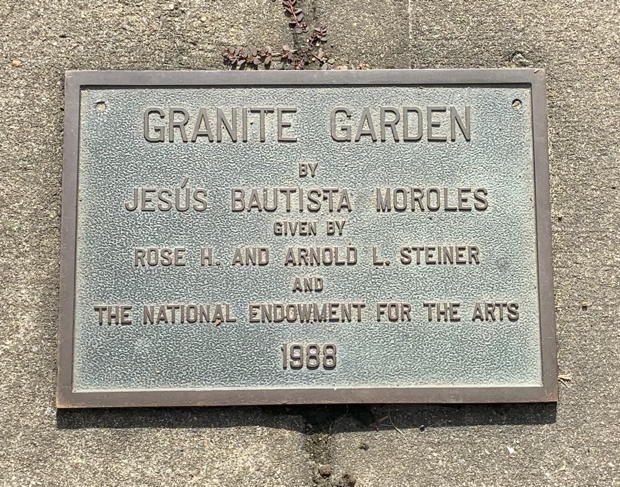We’ve developed a tradition here at The Well where each summer we offer something a little different to our audience — something to support the work of rest, restoration, and preparation that we hope is part of the season’s different rhythms.
This year we are offering our Summer 2021 Visio Divina Series. You can read more about this practice in our introduction to the series. Today, we'll take a close look at a piece by artist Jesús Bautista Moroles.

Jesús Bautista Moroles, Granite Garden, (1988, Birmingham Botanical Gardens). Photograph by Karen Hice Guzmán, 2021.
Week 8: Granite Garden
Questions for visio divina
- As you begin, take a few deep breaths. While we know God is always with us, invite the Holy Spirit to be present and to speak to you afresh in these moments. Spend some time looking at the image. What do you see? Similar to doing Bible study, make as many observations as you can. What do you like or dislike? Why? What questions do you have?
- How does the artist use color, light, style, composition, and material? What do you think the artist wanted to communicate? What stands out to you? Why do you think this is so?
- Read Isaiah 61:1-3, 10-11. How does this add to what you are seeing? Is there other Scripture that comes to mind?
- Spend some time reflecting on the Scripture passage and looking again at today’s image. What is God’s invitation to you? What might you need to see, understand, or believe? How does your current life experience intersect with what you are seeing and reflecting on? How might this image help you pray today? What do you want to say to God? Ask from him?
Scripture passage: Isaiah 61:1-3, 10-11.
The Spirit of the Sovereign LORD is on me,
because the LORD has anointed me
to proclaim good news to the poor.
He has sent me to bind up the brokenhearted,
to proclaim freedom for the captives
and release from darkness for the prisoners,
to proclaim the year of the LORD’S favor
and the day of vengeance of our God,
to comfort all who mourn,
and provide for those who grieve in Zion —
to bestow on them a crown of beauty
instead of ashes,
the oil of joy
instead of mourning,
and a garment of praise
instead of a spirit of despair.
They will be called oaks of righteousness,
a planting of the LORD
for the display of his splendor.
I delight greatly in the LORD;
my soul rejoices in my God.
For he has clothed me with garments of salvation
and arrayed me in a robe of his righteousness,
as a bridegroom adorns his head like a priest,
and as a bride adorns herself with her jewels.
For as the soil makes the sprout come up
and a garden causes seeds to grow,
so the Sovereign LORD will make righteousness
and praise spring up before all nations.

Karen's Reflection
A few weeks ago I was in Birmingham, Alabama for a conference and I stayed a couple extra days for a much needed personal retreat. I was delighted to discover The Birmingham Botanical Gardens and spent several hours there with my journal, reflecting over the last year and a half (more on that in next week’s piece). Just inside the entrance is this wonderful sculpture by Jesús Moroles. Almost instantly I was reminded of a forest. Two things in particular caught my attention. The first thing I noticed was the curves of the vertical elements. Trees, when clustered together in close proximity, arc and bend reaching for the light to sustain their growth, to sustain their existence actually. The second thing that caught my attention was the horizontal base pieces. They don’t lay evenly aside one another creating a smooth surface for the vertical pieces to rest on. Have you ever walked through a forest and noticed how the surface of the ground is rarely level? More often it bumps up here and sinks there as roots grow and wind their way through the soil. Did you know that often a tree’s root system is three times as large as its canopy overhead? To provide the nutrients, water, and support a tree needs to sustain its life, it requires this large underground network and activity. We rarely see much of it, but when several trees are clustered together, sometimes the surface of the ground gives clues to all that’s going on below. Here is another fact about the life of trees I find amazing: they look independent — maybe even in competition with one another as they stretch upward seeking the sun — but underground they communicate with each other and share vital nutrients through what some have termed the “wood wide web”!
It’s a beautiful picture, isn’t it? We are created by God as unique individuals, but we thrive in community. Knowing what happens beneath the surface has made me wonder about the bending and twisting of trees above ground. What if, instead of competing for sunshine to sustain their individual growth, they are actually moving to accommodate and provide for the growth of the trees around them? What if, for the sake of another, a tree becomes distorted in its own shape? I don’t want to push this point too far — as if trees are contemplating how to be selfless à la Philippians 2:3-4. But it does make me wonder about myself and the way I am (or am not) connected to those around me and how willing I am (or am not) to give in or give up in order that someone else might have what they need. Am I willing to be distorted or misshapen — literally or figuratively — so that someone else might thrive? Am I okay with not getting my way all the time? Will my identity stay intact if I am misunderstood? Can I trust the Lord with my reputation and future?
Who knew when I stopped to look at an art installation that all these hard questions would bubble up? But sometimes our life with God is more questions than answers.
Scripture is clear: we were made for relationships with God and with others. This has always been a challenge for human beings, but for us in the West — where individualism is in our DNA — it is particularly difficult. But we are called to live our life of faith in community. It is where we flourish and it is where God is seen.
They will be called oaks of righteousness,
a planting of the LORD
for the display of his splendor.
Prayer
Lord, you are the awesome and wonderful Creator! We praise you for your amazing works and how the creation not only displays your beauty and creativity, but it even reminds us of truths about the lives we are called to live. Thank you for making us unique people who are called to exist in life-giving community with one another. We confess we often don’t do this very well and we lament all that it costs to our flourishing and to your renown. Forgive us and in your mercy, grow us in our ability to love and care for one another. We long to be people who, in the words of Isaiah, display your splendor. Amen.
Where is God drawing your vision today? Take a photo and share your thoughts using our hashtag — #visiowell — on Instagram, Twitter, or Facebook.